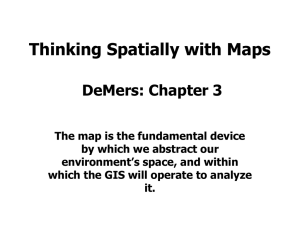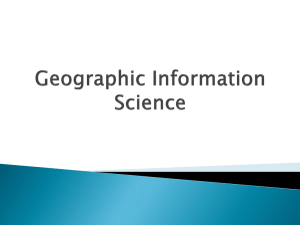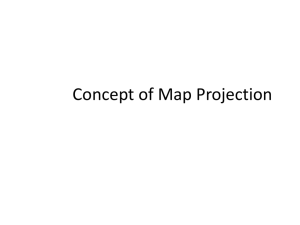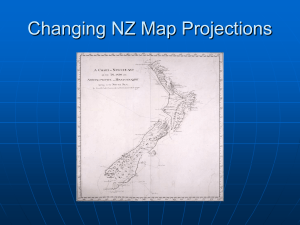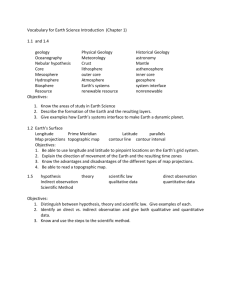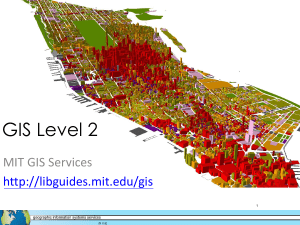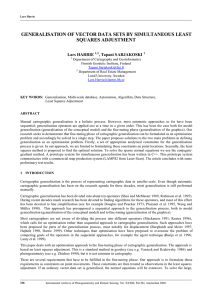Division of map projections according to their construction
advertisement
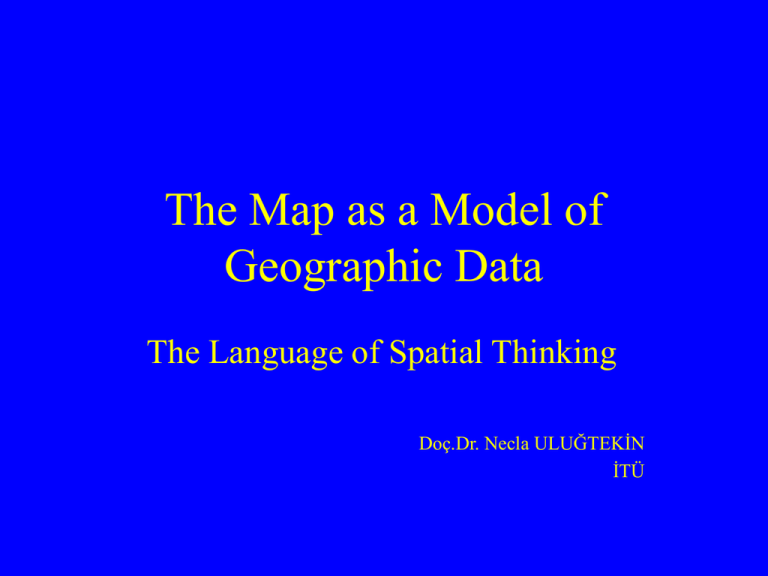
The Map as a Model of Geographic Data The Language of Spatial Thinking Doç.Dr. Necla ULUĞTEKİN İTÜ Spatial thinking requires us to be able to select observe measure catalogue characterise what we encounter. Data are collected •in the field •remote sensing •existing maps •catalogues • ... basic (absolute) data basic (absolute) data derived data derived data A knowledge about cartographic methods will increase a portion of our spatial vocabulary that we have called graphicacy. • Existing maps into the GIS – Different level of generalisation – Different level of scales – Different projections – Different symbolisation Cartography is the art, science and technology of making maps together with their study as scientific documents and works of art. (1973, ICA) Cartography is the organisation, presentation, communication and utilisation of geo-information in graphic, digital or tactile form. (ICA, 1991) Map • an abstraction of reality, it is not reality itself. • the fundamental language of geography. • symbolise image of geographical reality – representing selected feature – representing feature relationships – representing characteristics Maps can be used • • • • • • • Navigation Exploration Discovery Interactive computer navigation Education Forecasting … Primary Types of Maps • Topographic Map (General Reference) • Thematic Map GIS works together • • • • geology surveying soil science other disciplines GIS is used in these disciplines, in addition to • • • • Geological maps Topographic maps Cadastral Maps Soil Maps The thematic context of GIS includes • • • • • • • Vegetation maps Transportation maps Animal distribution maps Utility maps Urban plans Zoning maps ... GIS is • • • • hardware software people (organisation) data GIS is about • data integration • spatial analysis • link with application based models The traditional approach to mapping called the communication paradigm The map was a final product designed to communicate a spatial pattern through the use of symbols, class limit selection and so on. The traditional method was limited because raw, pre-classified data are not readily available to the map user Communication Paradigm Real World Cartographer Conception Map Map User Conceptions The alternative approach to cartography which is computer technology called the analytical or holistic paradigm Maintains the raw attribute data inside a computer storage device and display data based on user needs and user classifications Map Scale • Scale is the ratio of distance on the map to the same distance as appears on the earth • Methods of illustrating map scale – verbal scale 1mm = 1000 mm – representation fraction 1:1000 – graphic or bar scale • 1:1000 1:5000 1:10 000 1:25 000 Generalisation • Every map is, in principle, generalised. • Why? – increasing density of the map contents due to scale reduction – limit of sharpness of the eye, printing capabilities – minimum sizes • the choice of degree of generalisation depends on aim and scale of the map. Map Characteristics • Maps as images of the world, represent the locations of objects, as well as their qualities or magnitudes. • Objects are represented as points, line, areas or surfaces in the computer memory as like in the reality. Objects Entities Attributes Geometric Data house owner coordinates parcel use coordinates Levels of data measurements • qualitative or nominal level • ordered or ordinal level • quantitative or interval level GRID SYSTEMS for MAPPING •Geographical Coordinates based on latitude and longitude for the locating of objects or features on the spherical earth or its reference globe. •Rectangular Coordinates or Plane Coordinates allows us to locate objects correctly on these flat maps. Map Projection • The three-dimensional geographic relationships of the Earth surface must be transformed to the two-dimensional plane of the map by any of several procedures called map projections. • Division of map projections according to their properties – – – – conform projections equivalent (Equal-Area) projections equidistant projection others Division of map projections according to their construction • cylindrical projections • conic projections • azimuthal projections Division of map projections according to their aspect • Polar (regular) • Equatorial (transversal) • oblique UNIVERSAL TRANSVERSE MERCATOR PROJECTION (UTM) • • • • • • • • cylindrical, equatorial, conform projection the area is covered by 80° South - 84° North latitude the earth is divided into 60 zones (each 6° longitude) 180° West Longitude - 0° - 180° East Longitude 20 latitudinal belts (each 8° latitude) scale factor = 0.9996 origin shifted 500 000 m to east (false easting) origin shifted 10 000 000 m to south for the southern hemisphere Projection surfaces The Cartographic Process • • • • data collection (first step of GIS) data compilation (classification and symbolism) map production map reproduction (output of GIS) Map symbolism • According to their dimensional characteristics – point symbol (location and identity) – line symbol (linear characteristics) – area symbol (provinces, countries, soil units) Map symbolism • According to their shape cartographic symbol grouped in three main categories – – – – pictorial or descriptive symbols geometric or abstract symbols letter or number symbols other symbols (pie graph, bar graph etc.) Thematic Maps • dot map is a proportional changing in data • choropleth map (value-by-area mapping) • statistical mapping – class interval selection • equal class or constant interval methods • variable intervals - arithmetic, logarithmic, other mathematical series, unsystematic … (contour line on a topographic map class interval selection for choropleth maps.) The Nature of Spatial Data • model construction and geographic object selection (surveying, photogrammetry, remote sensing, recycling old maps, statistical surveys) • select and construct cartographic representation (road map, topographic map, ...) • medium output (paper map or on-screen map) • Reality digital landscape model digital cartographic model map mental map What we learnt • new perspective (map, scale, communication, ...) • new concepts (cartography, generalisation, projection, ...) • new people


